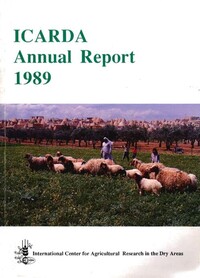ICARDA Annual Report 1989

Authors:
ICARDA faces a significant challenge in achieving sustainable agricultural production amid highly variable climatic conditions. The past two seasons vividly illustrated this variability. The 1987/88 season saw abundant rainfall, resulting in bumper crops across West Asia and North Africa. However, the following season, 1988/89, was one of the driest on record in several regions, including the Mashreq countries. This situation was exacerbated by an unfavorable distribution of rainfall and persistently low temperatures at critical points in the growing season. In contrast, some areas experienced good rainfall and satisfactory harvests.
These contrasting outcomes reaffirm the validity of ICARDA's research approach, which focuses on developing germplasm and production practices that enable crops to endure both weather extremes and various biotic stresses. They also serve as a caution against over-ambitious expectations for success in regions that typically receive marginal and erratic rainfall.
In striving for more intensive resource utilization, research and production must align with natural conditions rather than oppose them, taking into account the limitations that these conditions impose on our decisions. The 1988/89 season, which is the focus of this Annual Report, serves as a valuable reminder of this necessity, despite the economic challenges it presented in several cases.
